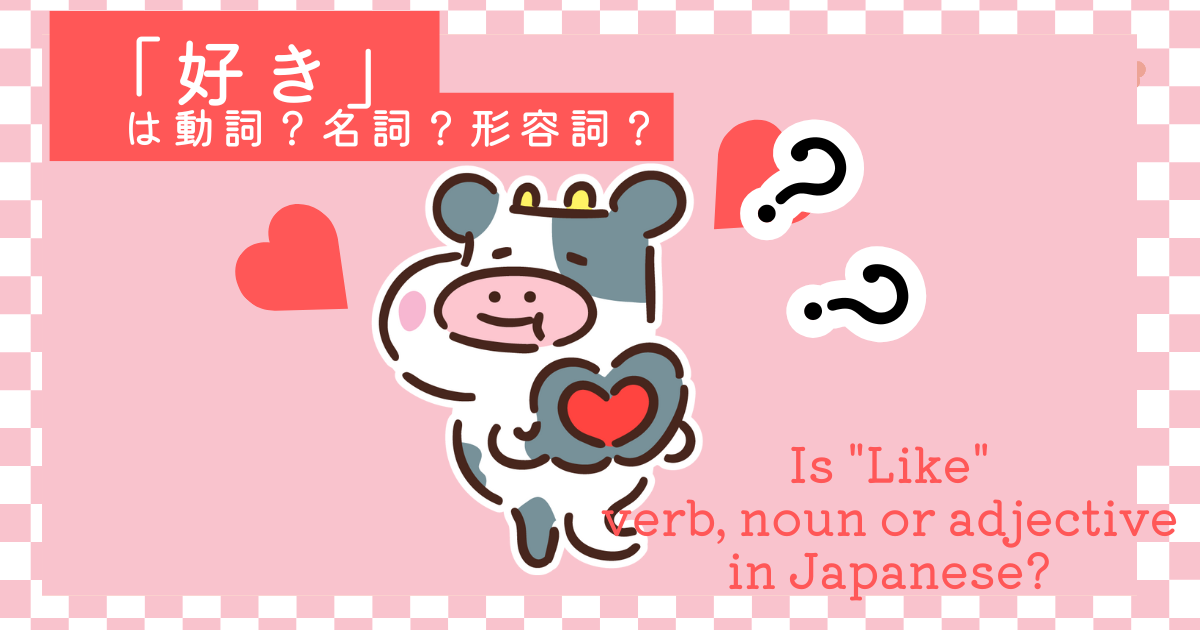-e1744201117989-150x150.png)
好きなものを伝える時は「○○が好きです。」と言います。
When you talk about what you like, you can say 「○○ga suki desu。」
ナ形容詞の「好き」に「です」をつけて…
We put Na-adjective” suki (like) ” and it is followed by ” desu ” …

「好き」は形容詞⁈
Is ” like” an adjective ?!
-e1744201117989-150x150.png)
形容詞⁈
Adjective ?!
「好き」は形容詞⁈
言語学習において早い段階で好きなものが言えるように練習します。
「私は緑茶が好きです。」「私の好きな食べ物はスパゲティです。」
会話する上で自分の好きなものを伝えること、相手の好きなものを知ることはとても大切です。
ここで文法を学ぶために日本語の「好き」を説明しようとすると、
「好き」=「like」=動詞?
「好きな色」=ナ形容詞?
「釣り好き」=名詞?
…と「好き」がどの品詞にあたるのか混乱するかもしれません。
実際のところ、すべて正解。
ただ、外国語話者のための日本語の教科書に沿って考えるなら、「好き」はナ形容詞にあたります。
理由としては、
- 名詞を修飾する際に「○○な」の形をとる
好きな色、好きな食べ物、好きな映画 - 丁寧形にしたときに「です」をつける
〇私は春が 好き+です。
✖私は春が 好き+ます。
Is ” like ” an adjective?!
We learn how to say what we like early in language learning.
” I like green tea.” “Spaghetti is the food I like.”
In conversation, it is very important to tell what I like, and to know what you like.
But when we explain “like” in Japanese…
“Suki”=”like”=verb?
“the color I like”=Na-adjective?
“fishing liker”=noun?
…we may be confused about which part of speech “like” is.
Actually, they are all correct.
However, if you follow a Japanese textbook for non native speaker, you can look “like” as Na-adjective.
Because,
・when modifying a noun, it takes the form “○○na”
“sukina iro” “sukina tabemono” “sukina eiga”
・In the polite form of the adjective, “desu” follows “like”
If “like” is a verb, “masu” follows “like”
〇 watashi wa haru ga suki desu.
✖ watashi wa haru ga suki masu.
「好き」は動詞じゃないの?
日本語研究者の中でも「好き」の品詞に関しては異なる意見があります。
品詞を理解するために「好き」という言葉の起源を調べていくと「好く」という動詞にたどり着きます。
この「好く」という言葉、少し古い言い回しで、現代の日常では「好き」として使うほうが一般的です。
彼は彼女を好く(動詞)
=彼は彼女が好き(ナ形容詞)
意味は同じ、でも「好き」のほうがよく使う
「嫌い」も同じく、「嫌う」という動詞がもともとの形です。こちらは現代でもよく使われます。
彼は虫を嫌う(動詞)
=彼は虫が嫌い(ナ形容詞)
もともとは同じ言葉、でも言語学習においてナ形容詞と考えていればわかりやすい、というところですね。
Is “like” not a verb?
Among Japanese language researchers, there are different opinions on the part of speech of “like”.
To understand the part of speech of the word “like”, we can look into the origin of the word “like”, which leards us to the verb “suku”
The word “suku” is a bit old-fashioned, and “suki” is more commonly used in modern everyday speech.
kare ha kanojo wo suku (verb)
=kare ha kanojo ga suki (Na-adjective)
They are same meaning, but we often use “suki”
Likewise, “kirau” is the original form of the verb “kirai”. In this case, both of them is used in modern times.
kare ha mushi wo kirau (verb)
=kare ha mushi ga kirai (Na-adjective)
Originally the same word, but it is easier to understand if you think of it as a Na-adjective in language learning.
日本語と英語で品詞が違う単語がある
外国語を勉強すると文法を勉強するために単語を調べます。その時に初めて単語の品詞を意識しだします。品詞が違うと活用も変わり、文法も変わるので混乱するかもしれません。
「好き」「嫌い」だけでなく、例えば「必要」「欲しい」も英語と日本語で品詞が違います。
どうして動詞?どうして形容詞?と疑問がわいた時にはその言葉の語源を調べてみるのもいいでしょう。
正直、日本の古文は現代人にとっては外国語のようなものです…
Some words have different parts of speech in Japanese and English.
When you study a foreign language, you look up words to study grammar. It is the first time you become aware of the part-of-speech of a word. When the part of speech is different, the conjugation changes, and the grammar also changes, which can be confusing.
For example, “like” and “dislike” as well as ‘need’ and “want” have different parts of speech in English and Japanese.
Why verbs? Why adjectives? When you have questions, it is a good idea to look up the etymology of the word.
Frankly speaking, Japanese archaic literature is like a foreign language to Japanese people today. ……




コメント